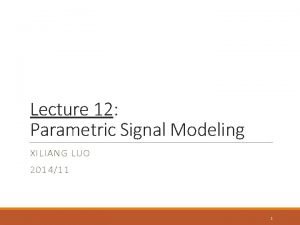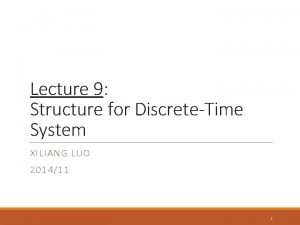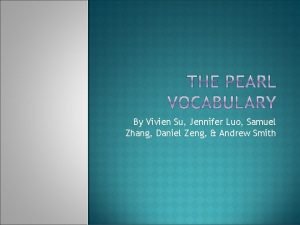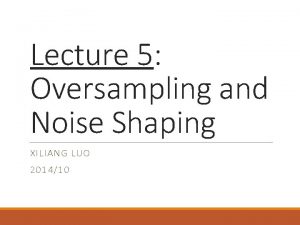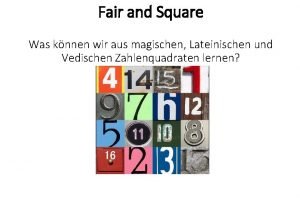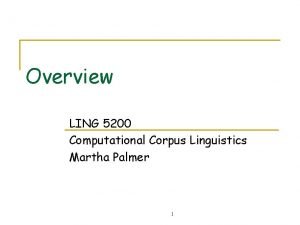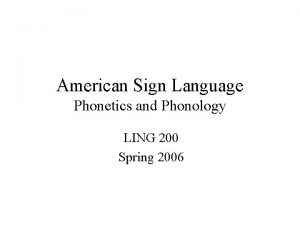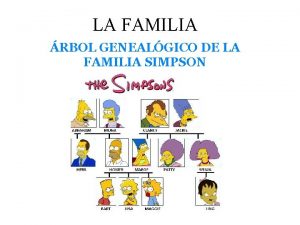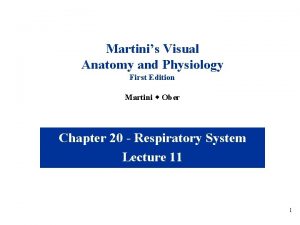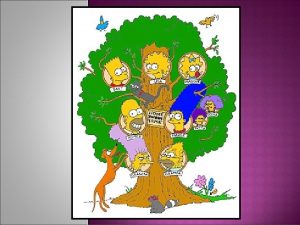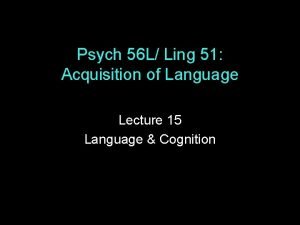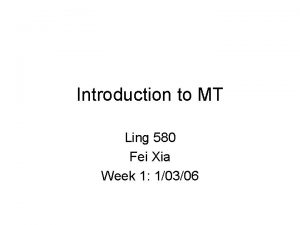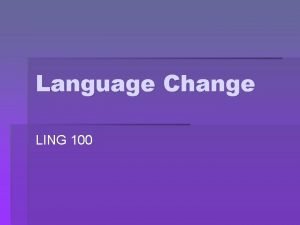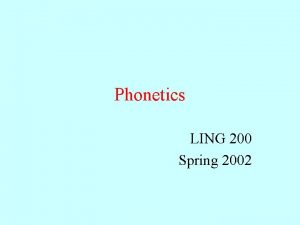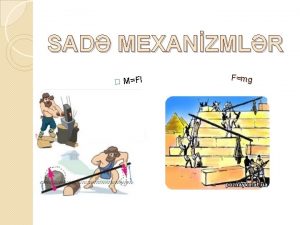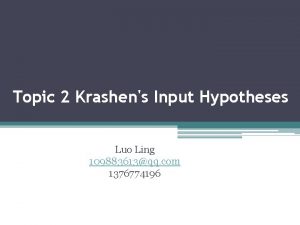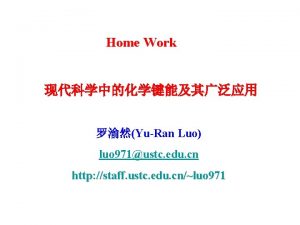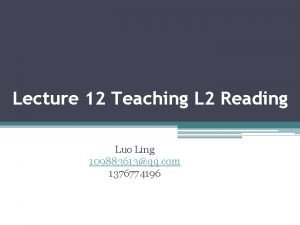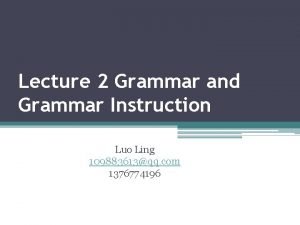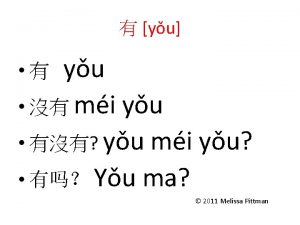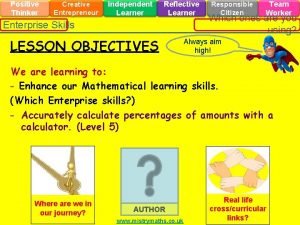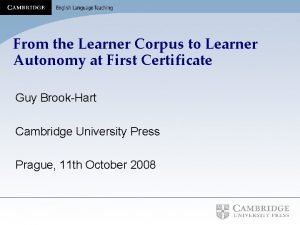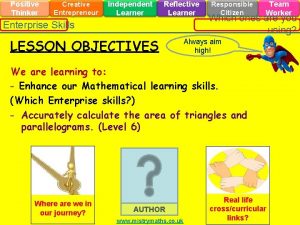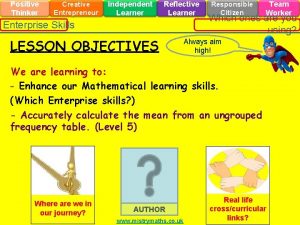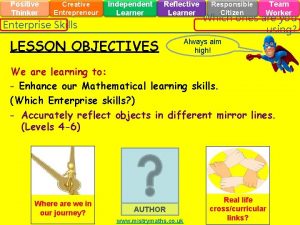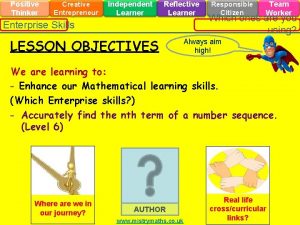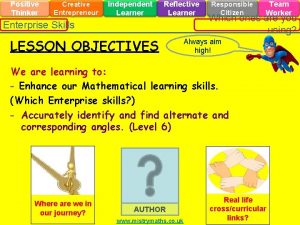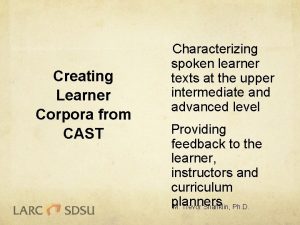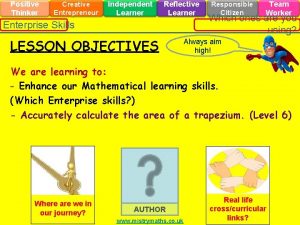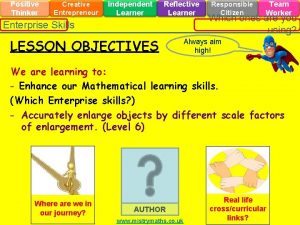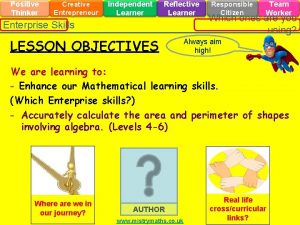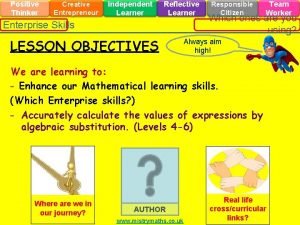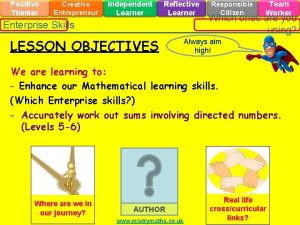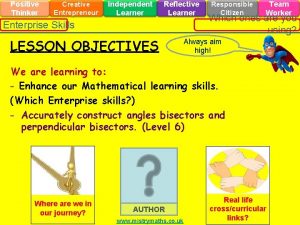Lecture 8 Learner Strategies Luo Ling 109883613qq com







![language learning strategies conscious and semiconscious[半清醒的] thoughts and behaviors used by learners with explicit language learning strategies conscious and semiconscious[半清醒的] thoughts and behaviors used by learners with explicit](https://slidetodoc.com/presentation_image_h/1fa9b39152f90ca33925a580851d326d/image-8.jpg)






![cognitive 认知学习策略 Repetition Re-combination Imagery[意象] Key word Contextualization[语境] Elaboration[详细阐述] Transfer Inferencing[推断] Resourcing Translation Grouping cognitive 认知学习策略 Repetition Re-combination Imagery[意象] Key word Contextualization[语境] Elaboration[详细阐述] Transfer Inferencing[推断] Resourcing Translation Grouping](https://slidetodoc.com/presentation_image_h/1fa9b39152f90ca33925a580851d326d/image-15.jpg)



![Communication strategy 交际策 略 avoidance or reduction strategies achievement or compensatory strategies stalling[停顿] or Communication strategy 交际策 略 avoidance or reduction strategies achievement or compensatory strategies stalling[停顿] or](https://slidetodoc.com/presentation_image_h/1fa9b39152f90ca33925a580851d326d/image-19.jpg)

![achievement or compensatory strategies • circumlocution[遁辞]: eg. the thing you open the bottle with achievement or compensatory strategies • circumlocution[遁辞]: eg. the thing you open the bottle with](https://slidetodoc.com/presentation_image_h/1fa9b39152f90ca33925a580851d326d/image-21.jpg)



















![Peer Tutoring[朋辈导修] Peer tutoring programs began in the 1970 s in Europe and are Peer Tutoring[朋辈导修] Peer tutoring programs began in the 1970 s in Europe and are](https://slidetodoc.com/presentation_image_h/1fa9b39152f90ca33925a580851d326d/image-41.jpg)



- Slides: 44

Lecture 8 Learner Strategies Luo Ling 109883613@qq. com 1376774196

Why do we need strategies? • As part of teaching responsibilities • As a way to developing learners' autonomy • As a way to learning to learn • As a way to reducing teachers’ work load

Position of strategy in L 2 learning Other knowledge: L 1 Social factors Input Language processing L 2 knowledge Output Individual differences Individual learner factors belief, affective state, general factors learner strategies

Background of strategies study studies of learning strategies as an “explosion of activity” in recent years failure of searching for the best teaching methods ~ learner-centeredness attention to the “black box” ~ individual factors promotion of autonomous/independent learners

Outline definition classification studies of strategies nature of strategies choice of strategies training of learning strategies

Definition Strategies : employed by learners aiming at improving performance in learning and using an L 2

Classification: learner strategies language learning strategies Cohen (1998) language use strategies self-motivating strategies
![language learning strategies conscious and semiconscious半清醒的 thoughts and behaviors used by learners with explicit language learning strategies conscious and semiconscious[半清醒的] thoughts and behaviors used by learners with explicit](https://slidetodoc.com/presentation_image_h/1fa9b39152f90ca33925a580851d326d/image-8.jpg)
language learning strategies conscious and semiconscious[半清醒的] thoughts and behaviors used by learners with explicit goal of improving their knowledge and understanding of a target language.

language use strategies for using the language that has been learned, however incompletely, including four sub-sets of strategies: lretrieval strategies lrehearsal strategies lcommunication strategies lcover strategies

self-motivating strategies used by learners to increase or protect their existing motivation. many researches have shown that learner' self-motivating capacity is a major factor contributing to success.

Classification: learner strategies Learning strategy 学习策略 Production strategy 表达策略 Communication strategy 交际策略

Learning strategy 学习策略 metacognitive 元认知学习策略 socio-affective 社会/情感学习策略 Chamot, 1987; Oxford, 1990)

metacognitive 元认知学习策略 • consicously used • for self-management (control by planning, monitoring and checking) or self-evaluation

Importance of metacognitive strategies Students without metacognitive approaches are essentially learners without direction or opportunity to review their progress, accomplishment, and future directions. O’Malley et al. (1985)
![cognitive 认知学习策略 Repetition Recombination Imagery意象 Key word Contextualization语境 Elaboration详细阐述 Transfer Inferencing推断 Resourcing Translation Grouping cognitive 认知学习策略 Repetition Re-combination Imagery[意象] Key word Contextualization[语境] Elaboration[详细阐述] Transfer Inferencing[推断] Resourcing Translation Grouping](https://slidetodoc.com/presentation_image_h/1fa9b39152f90ca33925a580851d326d/image-15.jpg)
cognitive 认知学习策略 Repetition Re-combination Imagery[意象] Key word Contextualization[语境] Elaboration[详细阐述] Transfer Inferencing[推断] Resourcing Translation Grouping Note-taking Deduction[演绎]

In short, cognitive strategies cover many of the process or mental manipulations that learners go through in both learning and using the target language.

socio-affective 社会/情感学习策略 • Cooperation • Asking for help • Question for clarification • Managing emotions

Such strategies are usually directed at increasing the learners' exposure to L 2 communication and to interactive practice.
![Communication strategy 交际策 略 avoidance or reduction strategies achievement or compensatory strategies stalling停顿 or Communication strategy 交际策 略 avoidance or reduction strategies achievement or compensatory strategies stalling[停顿] or](https://slidetodoc.com/presentation_image_h/1fa9b39152f90ca33925a580851d326d/image-19.jpg)
Communication strategy 交际策 略 avoidance or reduction strategies achievement or compensatory strategies stalling[停顿] or time-gaining strategies interactional strategies

avoidance or reduction strategies • message abandonment: eg. leaving a message unfinished because of language difficulties • topic avoidance: eg. avoiding topics which pose language difficulties • message replacement: eg. substituting the original message with a new one because of not feeling capable of executing it
![achievement or compensatory strategies circumlocution遁辞 eg the thing you open the bottle with achievement or compensatory strategies • circumlocution[遁辞]: eg. the thing you open the bottle with](https://slidetodoc.com/presentation_image_h/1fa9b39152f90ca33925a580851d326d/image-21.jpg)
achievement or compensatory strategies • circumlocution[遁辞]: eg. the thing you open the bottle with (corkscrew) • approximation: eg. ship for sailing boat • use of all-purpose words[通用词]: eg. the overuse of thing, stuff, etc. • word-coinage: eg. vegetarianist for vegetarian(non-existing, based on supposed rules)

achievement or compensatory strategies • use of non-linguistic means: eg. mime, gesture, facial expression or sound imitation • literal traslation: eg. traslating literally an idiom from L 1 to L 2 • foreignizing: eg. using an L 1 word by adjusting it towards the L 2 (adding a L 2 suffix to it) • code switching[语码转换]: eg. including an L 1 word with L 1 pronunciation in L 2 speech

stalling or time-gaining strategies • use of fillers and other hesitation devices: eg. well, let me see, as a matter of fact • repetiton: either by the speaker or the conversation parter

interactional strategies • appeal for help: eg. rising innotation, pause, eye contact, puzzled expression • asking for repetition: eg. sorry, pardon • asking for clarification: eg. what do you mean, the what • asking for comfirmation: eg. do you mean

interactional strategies • expressing non-understanding: eg. sorry, I don't understand • interpretive summary: eg. so what are you saying is

studies oflearner” strategies “Good language study (Rubin, Naiman et al, 1970 s) Attend to form and meaning Actively involved in learning Aware of the process Flexible and appropriate use of learning strategies

studies of strategies Correlational studies • Strategies and L 2 proficiency • Strategies of high and low achievers • Strategies and L 2 learning

studies of strategies • Strategy relates to stage of L 2 development. • Successful learners use strategies more frequently. • Successful learners focus on both form and meaning. • Different strategies contribute to different aspect of L 2 proficiency. • Successful learners employ strategies flexibly.

nature of strategies Learning strategies are problem-oriented No distinction of good or bad, its effect varies according to different person, task etc. A strategy can be effective or ineffective for individuals Strategies can be learned and trained. Language learners will be facilitated if aware of strategies they can consciously select in learning.

choice of strategies Individual learner differences • Belief • Affective state • Learner factors • Learning experience Situational and social factors • Target language • Sex • Cultural background • Learning setting and teaching methods

Strategy training Training for learner autonomy -independent learners

goals of strategy training • Self-diagnose their strengths and weaknesses in language learning • Become aware of what helps them to learn the target language most efficiently • Develop a broad range of problem-solving skills • Experiment with familiar and unfamiliar learning strategies • Make decisions about how to approach a language task • Monitor and self-evaluate their performance • Transfer successful strategies to new learning contexts

goals of strategy training • Monitor and self-evaluate their performance • Transfer successful strategies to new learning contexts

models of strategy training 4 -step model CALLA approach PPP

4 -step modeling practice application evaluation Oxford et al. (1990)

CALLA : cognitive academic language learning approach • • • Introducing Teaching Practicing Evaluating Applying • Chamot & O’Malley 1994

PPP • • • Presentation Explanation of what a strategy looks like and how it works. modeling/giving examples Practice Activities: embed strategies in learning tasks in authentic materials Repetitive and regular encounters Production Individual use Evaluation

Ways of strategy training programs general study-skills course awareness training strategy inserted into materials(language textbooks videotaped mini-courses) strategies-based instruction

General Study Skills Courses These courses are sometimes intended for students with academic difficulties but can also target successful students who want to improve their study habits.

Awareness Training: Lectures, Discussion and workshop Also known as consciousness-raising or familiarization training, this consists most often of isolated lectures and discussions and is usually separate from regular classroom instruction. Short workshops are another, usually more intensive, approach to increasing learner awareness of strategies through various consciousness-raising and strategy-assessment activities.
![Peer Tutoring朋辈导修 Peer tutoring programs began in the 1970 s in Europe and are Peer Tutoring[朋辈导修] Peer tutoring programs began in the 1970 s in Europe and are](https://slidetodoc.com/presentation_image_h/1fa9b39152f90ca33925a580851d326d/image-41.jpg)
Peer Tutoring[朋辈导修] Peer tutoring programs began in the 1970 s in Europe and are flourishing in many universities across the United States.

conduction of strategy training • • determine learners’ needs determine resources for training select strategy for training prepare materials and activities conducting training evaluating training results revising training techniques

Give him a fish, he can live for a day; teach him how to fish, he can live for a lifetime.

Thank you!
 Dậy thổi cơm mua thịt cá
Dậy thổi cơm mua thịt cá Cơm
Cơm Eager learning
Eager learning Lynn luo
Lynn luo Qiong luo
Qiong luo Chem data extractor
Chem data extractor Qiong luo
Qiong luo Xiliang luo
Xiliang luo Xiliang luo
Xiliang luo Furtively synonym
Furtively synonym Sevoflurane
Sevoflurane Xiliang luo
Xiliang luo Magische quadrat 406
Magische quadrat 406 Oheishuoltajuus laki
Oheishuoltajuus laki 01:640:244 lecture notes - lecture 15: plat, idah, farad
01:640:244 lecture notes - lecture 15: plat, idah, farad Ling oa
Ling oa Ling internet
Ling internet Ling shih fu
Ling shih fu Ling
Ling Fibrous pericardium
Fibrous pericardium Minimal pair asl
Minimal pair asl Walter ling
Walter ling Ling
Ling Papas de marge simpson
Papas de marge simpson Artyom sidorkin
Artyom sidorkin Wang ling relationship
Wang ling relationship Not wild animals
Not wild animals Ling simpson
Ling simpson Erin ling
Erin ling Negen ling
Negen ling Ling
Ling Mtling
Mtling Dr ng li ling
Dr ng li ling Jin ling cigarettes
Jin ling cigarettes Long term goals
Long term goals Shi sheng ling
Shi sheng ling Ling adder
Ling adder Ling 100
Ling 100 Ling oa
Ling oa Cheung yin ling
Cheung yin ling Lam wai ling
Lam wai ling Ling 200
Ling 200 Nien-ling wacker
Nien-ling wacker Tərpənən blok
Tərpənən blok Mei-ling huang
Mei-ling huang







